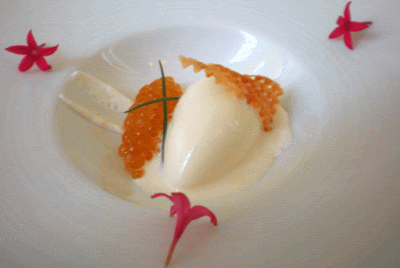17 Restaurant in the Alden-Houston has a new executive chef, Wesley Morton.
17 has had a string of talented chefs come and go. That isn't a bad thing. The frequent infusions of new blood let us see what is going on in that national food scene.
The national hotel chef sceneThe American restaurant system is a lot like the hierarchical French model. Baby chefs come out of culinary school. Then they train as underling chefs at many different restaurants as they slowly rise up the ranks. Many of these restaurants happen to be in hotels.
The result of all this moving is that the top young chefs get to know each other. They all speak the same language. They follow many of the same trends.
Take
Wesley Morton. After culinary school, he worked in D.C. at Circle Bistro, Cityzen Restaurant, and Citronelle (D.C.'s best restaurant). He last worked in Half Moon Bay, California at the Ritz Carlton's restaurant.
The next step is natural. For your first exec chef job, you start in a small, elegant hotel restaurant in some backwater market, or in this case, downtown Houston.
Morton's stated themes17's website lays out Morton's themes, which happen to be many of the current culinary trends:
•local foods: "his passion for bringing the 'farm to the table'"
•seasonal ingredients: "his philosophy of creating dishes that are at their seasonal peak in terms of flavor and eye appeal"
•organic: "I hope to play an instrumental role in helping change the way Houstonians eat in terms of local, fresh, and organic."
The unstated theme: minimalism17's website doesn't mention the most accurate description of Morton's approach -- minimalism. His dishes focus on simplicity, with remarkably few ingredients and basic flavors.
Consider Morton's ceasar salad, called "
gita's baby romaine." Under Chef Ryan Pera, 17 served a wacky, fried ceasar salad. [Correction: the fried salad was prior chef Jeff Armstrong's creation, even though it was served for a while under Pera]. Morton returns it to basics: large strips of romaine leaves stacked in neat rows, with a light dressing on each leaf, a few crutons scattered around the edge of the plate, and a single large anchovy draped across the middle.
Similarly, "
crudo of kona kampachi" is a beautifully simple dish raw fish, dressed with lime juice and sea salt, and served with thin slices of cucumber and baby shiso leaves. The lime and granules of salt highlighted the flavors of this fish, making it much more interesting than the sashimi version served in many sushi restaurants. But it was the spirit of minimalism that guided the appearance, distinct flavors, and small size of this dish.
My only question: if Morton is so high on local foods, why use a Hawaiian kona kampachi, a type of amberjack, when we have outstanding amberjack right here in the Gulf?
Under the header "local market fish," the special was
king salmon. Again, king salmon is hardly a local fish, but I guess you can buy at "local markets." The waiter said it would be served with morels. I told him, "Morels, really? those are my favorite mushroom." He assured me it had morels. When it arrived, it had a completely different kind of mushroom, probably a chanterelle. Deprived of morels, I still enjoyed the dish. The salmon was thick and cooked rare. It sat atop a small bed of soft potato gnocchi and mushrooms. On the side was a small dab of tartar sauce -- not the kind you get in Luby's, but a delicious, smooth, herbed tartar sauce.
Perhaps the best dish of the night was an
heirloom tomato salad. The tomatoes were a mix of different sizes and colors, all tasty. They were served with baby arugula and burrata cheese, from Puglia, Italy (hardly local). If the dish had stopped there, it would have fit perfectly into Morton's minimalist aesthetic. But it was topped with a delicious, fried squash blossom stuffed with a soft cheese. This one excess made the dish a home run.
The verdictMorton undercuts his "local" theme by serving salmon from Alaska, amberjack from Hawaii, and cheese from Italy. But the truth is, Houston does not have a wealth of great local ingredients. And the market for good local ingredients may have been locked in by Monica Pope. So in Houston, unless you are Monica, you almost
have to ship in some non-local foods to make a good meal. [Correction: Ok, that was a silly exaggeration. But seriously, in Houston good local foods take a lot of work to find.]
Morton's real theme -- minimalism -- works. Minimalism is hard to pull off. You have to have great ingredients. You have to use smart techniques to highlight an ingredient's flavors without changing them. And you have to have thoughtful ingredient pairings. This type of approach is hard work.
But when it does work, minimalism can bring out the pure flavors of distinct ingredients. It can make you look at an ordinary ingredient in a new light. And it can make you feel good because you know exactly what you are eating.
I recommend that you try Wesley Morton's minimalist cooking at 17 before he moves on to bigger and better things.
 Flavored olive oils, a new sauce pot, and a bacon-chocolate bar.
Flavored olive oils, a new sauce pot, and a bacon-chocolate bar.














































